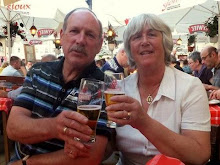With loads more rain last night the towpaths were now awash. We had thought to stay at Coole Pilate and walk the 3/4 mile to the Secret Bunker but no way was I going to attempt to walk on all that slippery mud. With my history of falling over a blade of grass, I doubt if I would have stayed on my feet. So we moved to the 48 hour mooring top of Hack Green locks. By Jove that icy blast coming from the arctic certainly made that short cruise most unpleasant. And those waves were certainly a rocking FS!!! Very thankful to arrive and find it devoid of boats and so we took the first set of rings and moored right by the bridge.
 |
| Hack locks in the distance |
Then it was off to the Bunker.
 |
| Hack house What a marvellous crocked house. |
Brief History (Taken from Most Haunted web site)
Hack Green Nuclear Bunker started off as decoy site during the Second World War, to trick any German Luftwaffe bombers looking for the important railway junction at Crewe. In 1941 it became RAF Hack Green, and its purpose was to provide air traffic control to military aircraft crossing the nearby airspace.
During the early years of the Cold War, the site was modernised as part of the ROTOR project – a huge elaborate air defence system designed to counter any threat posed by Soviet bombers. During this modernisation, the construction of a semi-sunk bunker also took place.
In 1958 the site changed roles again, becoming part of the UK Air Traffic Control System. It was during this period that the site became an RAF centre. Hack Green closed in 1966 after it was replaced by RAF Lindholme in South Yorkshire.
The site lay dormant for several years until 1976 when, during the height of the Cold War, the site was purchased by the Home Office and used as a Regional Government Headquarters (RGHQs) – one of a network of 16 similar sites around the UK. They were designed to enable government to to continue in the event of a nuclear attack.
After the Cold War ended in 1992, Hack Green’s life as an active military facility had come to an end. The Home Office sold the site to a private buyer, and 1998, the Cold War Museum you see today was opened
 |
| Military communication room |
 |
| equipment used to warn of nuclear attack |
 |
| Internal telephone exchange |
 |
| Not the most comfortable of beds. |
 |
| Ballistic missile early warning system |
 |
| Death follows soon after radiation poisoning. |
Let us hope the likes of Nagasaki and Hiroshima never happens again.
And a photo taken before we set off this morning.
 |
| Coole Pilate mooring. Doesn't look wet and muddy, that towpath, but one needed to wear boots! |








No comments:
Post a Comment